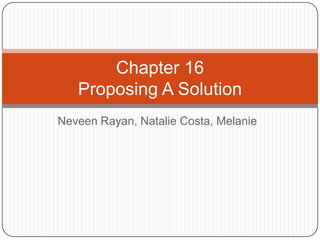Ch 16 enc
- 1. Chapter 16 Proposing A Solution Neveen Rayan, Natalie Costa, Melanie
- 2. Types of Proposals ï Practical Proposals -Target a specific audience, the writer briefly summarizes the proposal explaining its purpose ï Policy Proposal - Aimed at more general audiences instead of specific decision matters. -They address of public policy, with the aim of swaying toward the writers proposed solution. ï Proposal Argument - The power of proposal arguments can be enhanced through visual images, which appeal to both logos and pathos. - These arguments may be brief, catchy, clear and lively, they often employ document design- fonts, layout, graphics, images and color for the maximum advantage. - Delivered as speeches or power points when in a formal setting.
- 3. Key Elements Of Proposals ï Description of the Problem ï Informs the reader about where the problem appears, who the problem affects, how long the problem has been around and if the problem is getting worse. This section analyzes the problem. What are the elements? What are its causes? Why hasnât it been solved before? It shows the problems significance and the negative consequences of not solving the problem. ï Proposal for a Solution ï Describes your solution and shows how it could work. The purpose of planning proposal is to call attention to a serious problem. This section should propose a detailed solution, showing step-by-step how it would solve the problem and at what cost. ï Justification ï This is where you persuade your audience that your proposal should be enacted. Show that the benefits of your proposal outweigh the cost, and also show why your solution is better than alternative solutions.
- 4. The Demands of Proposal Writing ï Creating Presence ï Help the readers see and feel the problem. Writers often use anecdotes or examples of people suffering from the problem to dramatize it. Persuades readers both mentally and emotionally. ï Appealing to the Interests and Values of Decision Makers ï Urging the audience to do the right thing and show how doing the right thing converges with the readerâs best interest, benefiting them directly. ï Overcoming Inherent Conservatism ï Proving that something needs to be changed. It is much harder to stir the audience to action when the problem you depict entails lost potential. ï Predicting Consequences ï resist change because they fear consequences. Show how the proposal will bring about the consequences topersuade your audience that your predictions are realistic identify the links in the chain and identify how one leads to the next.
- 5. Developing an Effective Justification ï Using a three strategy approach - Focuses on principles, consequences and precedents/analogies.
- 6. Strategies for Composing a Proposal Argument ï Argument from principle ï Arguing that an action should or should not be taken because it is right or wrong. ï Argument from consequence ï An action should or should not be taken because it will lead to either good or bad consequences. ï Argument from precedent or analogy ï An action should or should not be taken because it could turn out well or badly.
- 7. Organization of A Proposal Argument ï Arguments must capture attention, give presence to a problem, advocate a solution and enlist their support. ï Photographs, drawings, graphs or other images. ï Attention grabbing verbal visual texts (posters, flyers, paid advertisements, web pages) ï Introduction (Well defined problem), body paragraph (Convincing argument in support of the proposed solution), conclusion (Call to action)







